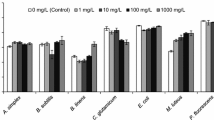Abstract
The effect of the gaseous metabolites of onePseudomonas fluorescens culture on the attachment of cells of anotherP. fluorescens culture to glass was studied. Gaseous metabolites increased the number of unattached cells by 10–30% and the mean residence time of cells attached to glass by 100%. These effects were presumably due to the yet unidentified compound, which we called volatile antiadhesin. This compound could be adsorbed by activated charcoal and HAYESEP-Q adsorbent.
Similar content being viewed by others
References
Stozky, G. and Schenck, S., Volatile Organic Com-pounds and Microorganisms,CRC Crit. Rev. Microbiol., 1976, vol. 4, no. 4, pp. 333–382.
Wheatley, R.E., Millar, S.E., and Griffits, D.W., The Pro-duction of Volatile Organic Compounds during Nitrogen Transformation in Soils,Plant Soil, 1996, vol. 181, pp. 163–167.
Fiddaman, P.J. and Rossal, S., The Production of Anti-fungal Volatiles byBacillus subtilis, J. Appl. Bacteriol., 1993, vol. 74, pp. 119–126.
Flavier, A.B., Clough, S.J., Schell, M.A., and Denny, T.P., Identification of 3-Hydroxypalmitic Acid Methyl Ester as a Novel Autoregulator Controlling Virulence inRal- stonia solanaceum, Mol. Microbiol., 1997, vol. 26, no. 2, pp. 251–259.
Salmond, G.P.C., Bycroft, B.W., and Stewart, G.S.A.B.,et al., The Bacterial “Enigma”: Cracking the Code of Cell-Cell Communication,Mol. Microbiol., 1995, vol. 16, no. 4, pp. 615–624.
Nikolaev, Yu.A. and Prosser, J.I., Extracellular Factors Affecting the Adhesion ofPseudomonas fluorescens Cells to Glass Surfaces,Mikrobiologiya, 2000, vol. 69, no. 2, pp. 231–236.
Nikolaev, Yu.A. and Prosser, J.I., Some Properties ofPseudomonas fluorescens Adhesin and Antiadhesin, Mikrobiologiya, 2000, vol. 69, no. 2, pp. 236–242.
Sambrook, J., Fritsch, E.F., and Maniatis, T,Molecular Cloning: A Laboratory Manual, Cold Spring Harbor: Cold Spring Harbor Lab., 1989, vol. 3, p. 3.
Evdokimova, N.V., Dorofeev, A.G., and Panikov, N.S., Dynamics of Survival and Transition to Dormancy of Nitrogen-starvedPseudomonas fluorescens, Mikrobi-ologiya, 1994, vol. 63, no. 2, pp. 195–203.
Author information
Authors and Affiliations
Rights and permissions
About this article
Cite this article
Nikolaev, Y.A., Prosser, J.I. & Wheatley, R.E. Regulation of the adhesion ofPseudomonas fluorescens cells to glass by extracellular volatile compounds. Microbiology 69, 287–290 (2000). https://doi.org/10.1007/BF02756735
Received:
Issue Date:
DOI: https://doi.org/10.1007/BF02756735



